Guildford
1913 saw
the opening of a handsome new Electricity
Works on Onslow Street to provide power for Guildford town
centre. As electricity consumption rose over the following
years
it became clear that a bigger station was needed. A
replacement
building opened on another site in May 1928. The Electricity Works was
retained as a distribution centre and all the town centre mains
radiated from this point.
After 1968 the building lay dormant, used only as a scenery store for
the various amateur theatre groups based in the area. Twenty years
later the building's potential as a theatre was recognised.
Guildford Amateur Theatre Association (GATA), representing the
interests of the many amateur arts companies in the area, began to
lobby the Borough Council for a new base. GATA was successful and 1997
saw the opening of ‘The Electric Theatre’.
The design project was undertaken by the Borough Council
architects. The 1913 Electricity Works building houses the
theatre space itself, with extensions housing the foyer, bar,
restaurant, dressing rooms, Farley Room and toilet
facilities.
The Theatre has retractable seating for 210, a wooden sprung floor, an
orchestra pit and first class technical equipment.
'1913
ELECTRICITY WORKS.'
is still
boldly readable in white condensed capitals on
the rear of the building which overlooks the river Wey, but it's
clearly readbale from the restaurant of the YMCA, from which these
photographs were taken. On careful inspection, rather than stuck on
characters, these appear to be in white ceramic tile, built into the
brickwork: hence the bright colour.
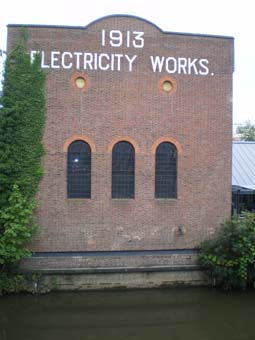
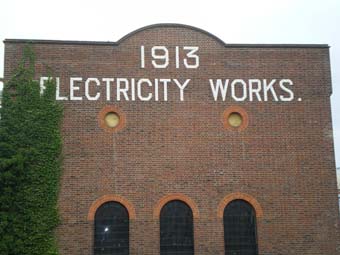
In 1895
John Dennis (1871-1939) opened the Universal
Athletic Stores in High Street, Guildford. He was joined by his brother
Raymond Dennis (1878-1939) and they began producing the 'Speed King'
and 'Speed Queen' bicycles. The brothers expanded into motor tricycles,
and by 1900 were making motor quadricycles.
In 1901 Dennis Bros. Ltd moved into a factory designed for the
production of their motor vehicles on the corner of Onslow Street and
Bridge Street, in Guildford. This building was later known as Rodboro
Buildings, after the Rodboro Boot and Shoe Company who bought the
building from Dennis in 1917 and subsequently it became a confectionery
warehouse. The latest renovations were undertaken in the early 1990s.
The Dennis brothers launched their first motor car in 1902, buses in
1903, followed by vans and lorries, and fire engines, the most famous
of Dennis vehicles, from 1908. Dennis vehicles, especially fire
engines, were exported around the world, including to the fire services
of Singapore, Athens, Brisbane, Barbados, Cairo, Penang and Shanghai.
This three-storey, brick-walled building is probably the earliest
surviving purpose-built car factory in England. Cars were lifted from
floor to floor by lift to be finished on the top floor under roof
lights; they were then lowered to the ground floor showroom. The
building was soon outgrown by the company who moved production
elsewhere in 1905 although it continued to use the Rodboro Buildings as
offices.
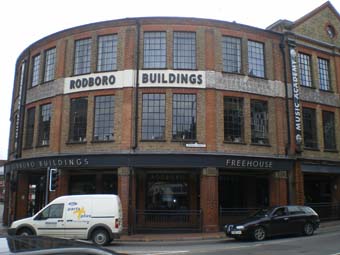
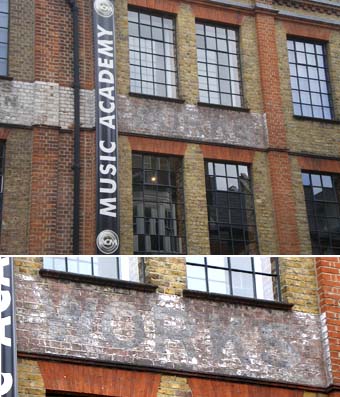
We deduce
that the word in caps painted under the
screw-on lettering '('Rodboro Buildings') is "RODBORO' as its flanked
by the smaller lettering below, which is then followed by the word
'WORKS' (see above). Compare with lettering at the rear of the
building. Once threatened by demolition, this Grade II listed building
is currently occupied by Wetherspoons as a pub/club on the ground floor
and The Academy of Contemporary Music above.
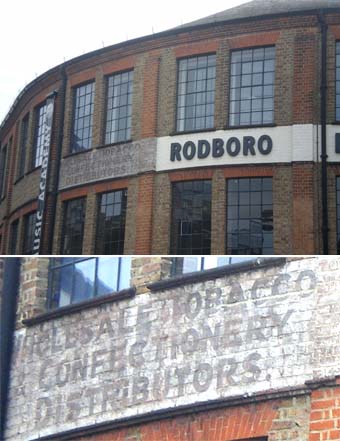
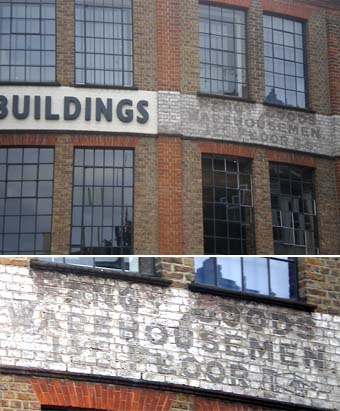
'WHOLESALE
TOBACCO
CONFECTIONERY
DISTRIBUTORS'
'FANCY GOODS
WAREHOUSEMEN
1ST
FLOOR' (+ pointing finger)
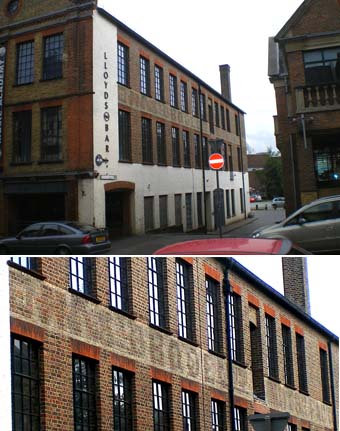
Here, at
the rear of the bulding is rather more
vestigial characters (probably two generations of lettering): 'RODBORO
WORKS'[?] and underneath (probably): 'DENNIS BROS. MOTOR WORKS
(PARTS?)' after the original owners. It looks as if the Initial 'D' of
'Dennis' is covered up by the white-painted background bearing the
vertical lettering 'Lloyds Bar'. The Rodboro Building is well-known
locally as being in the centre of a large roundabout including the
Electric Theatre and the YMCA: the traffic is certainly fast and
hazardous. We now move up the steep High Street.
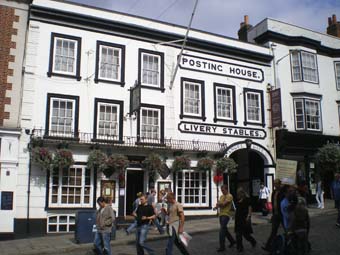
The Angel
Posting House & Livery whose story
stretches back to the Middle Ages is a fascinating timber-framed
building in the centre of Guildford's Historic High Street. It occupies
two of the plots laid out in Saxon times; however at some time in the
fifteenth century the properties were combined under one ownership. The
oldest part of the hotel is the stone vaulted undercroft that dates
back to the 1300s and still has the remains of the original spiral
staircase.
The earliest documentary evidence for the building is in a deed from
Pancras Chamberlyn of 1527 when Sir Christopher More bought the
building called the Angel for £10.00. His son and heir who
was a
favoured minister of Queen Elizabeth, and who built nearby Loseley
House (open to the public), sold the lease in 1545. The new owner was
John Hole, a shoemaker but the details of rooms and stabling suggest it
was an inn by this time. The roof of this period still remains and from
the inn you can see the northern gable which conceals curious timbers.
In 1606 John Astret left this "Hospitio" (inn) to his son and it may
have been at this time that the inn was largely rebuilt. The splendid
Jacobean woodwork and panelling is very much a feature of the hotel as
is the massive brick fireplace, although this would have been built
earlier. By the main staircase hangs an original"Parliamentary" clock
which would have reminded travellers when their coaches were due to
depart. Since Guildford was on the main road from London to
Southampton, Winchester and Portsmouth throughout the centuries
numerous travellers would have passed through the town, especially
soldiers and sailors. Guests brought prosperity to the Angel; however
due to compulsory billeting of soldiers, the inn was bankrupt in the
late 1770's. (Sadly history seems to have repeated itself in 2009!)
The next owners were local brewers, firstly Frances Skurray and then in
1819 the Elkin family. It was in the height of the coaching era and
they probably added the present frontage. A stucco facade was applied
to the old timber-framed building and the signs added: 'POSTING HOUSE'
to indicate that fresh horses could be hired here, and 'LIVERY STABLES'
to show that customer's horses could be cared for in their absence.
Another reminder of this period is the hoist from the hayloft at the
right of the inn yard. More modern lettering over the archway, 'ANGEL
GATE' indicates the original coaching entrance, in modern times it
leads to a restaurant, shops and an alleyway.
The arrival of the railway in Guildford in 1845 brought an end to the
lucrative coaching trade, when in the High Street alone there were six
coaching inns and over 30 beer houses.With the exception of The Angel,
all the great coaching inns have disappeared over the years. One famous
guest who stayed here in 1876 was the young Prince Imperial of France
who was later killed in the Zulu Wars. The shadowy spectre of another
foreign soldier of this time has been seen occasionally in one of the
timber-beamed bedrooms.
In 1989 The Angel was sold to property developers who wished to convert
it into shops, but after a great public outcry planning permission was
refused and the hotel was saved. In 1990 the hotel was sold to
professional hoteliers who took great care in refurbishing the inn,
retaining much of the original structure and atmosphere of this
important centre of hospitality for many generations.
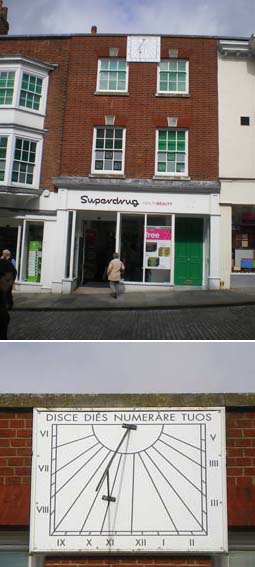
A
huge sundial hangs above Superdrug, 101 High
Street bearing the Latin motto: 'DISCE DIES NUMERARE TUOS'
(“Learn to number your days”). A vertical sundial
of a type
common in the 17th and 18th Centuries, this example may actually date
from the earlier 19th Century. (See Links
page for Suffolk Sundials and more sundials at Aldeburgh
and Woodbridge.)
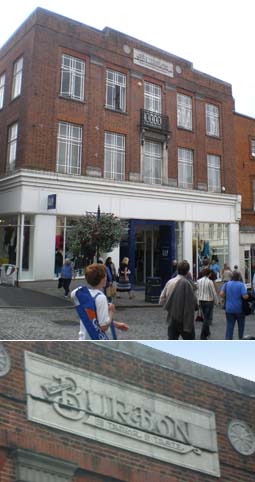
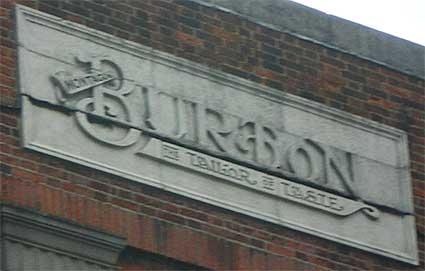
Here also
is a typically deco (albeit mainly in red brick) shop-front of:
'MONTAGUE
BURTON
THE
TAILOR OF
TASTE'
This trading banner predates the later and more
commonly seen 'Burton' and gives the full name of the
company's
founder on a building sign (albeit very high above pedestrians).
'Montague' is angled in a scroll; 'The' and 'Of' have underline and
overline, the rest in 1930s flourish font. 1900 saw Lithuanian
émigré Montague Burton arrive in Britain and
borrow
£100 to set up his own menswear business in Chesterfield. By
1906
he has started to establish a chain of shops selling both ready-to-wear
and bespoke suits. In 1910 the business relocated to Leeds. A
philanthopist, Burton received a knighthood in 1931 for 'services to
industrial relations'. By the end of the Second World War Burton was
estimated to be clothing around a fifth of the British male population.
In 1952 Sir Montague died. At the time of his death his company was the
largest multiple tailor in the world with 616 stores.
Burton's shop managers were told that if there was any surplus space in
the building, a poster was available from head office saying 'Billiard
Hall to let'. Initially Burton allowed these to be run by other people,
but finding that many of them also sold alcohol, and deciding this
compromised his hard-fought respectable image, he took them over
himself. Dance classes or offices were sometimes allowed to use the
extra space, but billiards, being an exclusively male activity, was the
preferred option. Many people still remember attending dance classes in
ballrooms above their local Burton shop.
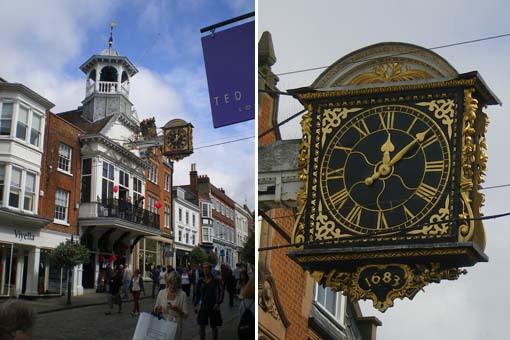
The
Guildhall in Guildford High Street is where the
Mayor and Corporation of Guildford met to regulate the commerce of the
Borough, and where the various Courts of Law sat in judgement.
The hall itself is Elizabethan, but very probably stands on the site of
the medieval Guildhall which is known to have existed in the
1300s. It was extended at the north end in 1589, on the
occasion
of one of Elizabeth I's visits to the town and her Coat of Arms in
stained glass was inserted in the window above the Judge's Bench.
Later the Arms of James I's Queen, Anne of Denmark, were also inserted,
together with the Arms of the Borough itself. Above the Bench
hangs a 16th century two-handed sword which has been carried before the
Mayor in formal processions since 1922. There are paintings
of
Charles II, James II and William and Mary, and also one of the colour
party of the Queen's Regiment commemorating the presentation of the
Freedom of the Borough in 1946.
In 1683 the Guildhall was refurbished with the insertion of a Council
Chamber at first floor level. This had a balcony over the
street
and a bell turret above. The story is told of a London clock
maker, named John Aylward, who presented the projecting clock to the
Corporation in return for freedom to trade in the Borough. The
spectacular gold and black clock is clearly dated '1683' at the bottom.
Our photograph was taken during a Heritage Open Day in 2009, when
visitors had access to the balcony.
Home
Return to Historic Lettering from outside
Ipswich
Please email any comments
and contributions by clicking here.
Search Ipswich
Historic Lettering
©2004
Copyright
throughout the Ipswich
Historic Lettering website: Borin Van Loon
No reproduction of text or images without express written permission











